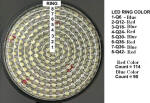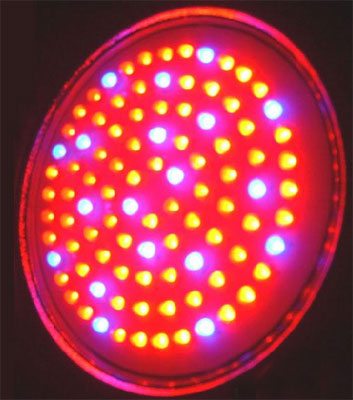|
LED
Plant grow lights
Grow
lights are usually used for indoor gardening, plant propagation
and food production, including indoor hydroponics and aquatic
plants. Although most grow lights are used on an industrial
level, some small-scale/domestic usage of these lamps has also
been found.
According to the inverse square law, the intensity of light
radiating from a point source (in this case a bulb) that reaches
a surface is inversely proportional to the square of the
surface's distance from the source. So if an object is twice as
far away, it receives only 1/4 the light. This is a serious
hurdle for indoor growers, and many techniques are employed to
use light as efficiently as possible. Reflectors are thus often
used in the lamps to maximize light efficiency. Plants or lights
are moved as close together as possible so that they receive
equal lighting and that all light coming from the lamps wind up
on the plants (rather than partly besides it). Often, the
distance between lamp and plant is in the range of 24 inches
(with incandescent lamps), up to 4 inches (with other lamps as
compact, large and high-output fluorescent lamps). Many home
gardeners cover the walls of their grow-room with a reflective
material, or alternatively, white paint to maximize efficiency.
Light requirements of plants
To determine the appropriate lighting (and the lamp to be best
used), the specific needs of the plant need to be determined. To
arrange optimum lighting, the lighting present in the plant's
natural environment need to be imitated. Of course, the bigger
the plant gets the more light it requires; if there is not
enough light, a plant will not grow, regardless of other
conditions.
For example vegetables grow best in full sunlight and high light
levels are needed to grow vegetables well indoors (fluorescent
lamps, or MH-lamps are thus preferred). Foliage plants (e.g.
Philodendron) grow in full shade and can grow normally with
relatively little artificial light (thus for the latter, regular
incandescents may already suffice).
In addition, plants also require both dark and light ("photo"-)
periods. Therefore, lights may to be timed to turn them on and
off at set times. The optimum photo/dark period depends on the
species and variety of plant (some prefer long days and short
nights and others prefer the opposite, or something in between).
For indoor gardening, one of the most important topics is light
density, measured in lux. Light density is the amount of light
incident on a surface. One lux equals one lumen (unit) of light
falling on an area of one square meter. A brightly lit office
would be illuminated at about 400 lux. In Imperial (pounds-feet)
terms, a foot-candle, or the intensity of a standard candle on
an area of 1 square foot, is about 10.76 lux. In professional
farming PAR watt or microeinstein per squaremeter
second is used instead of lux, because lux is optimized for
human vision, not for photosynthesis, and can be very misleading
in case of non-white lightsources, like the purplish-looking LED
growlights.
LED grow lamps
LED panel light source used in an experiment on plant growth by
NASA. Pictured plant is a potato plant. Recent advancements in
LEDs have allowed for the production of relatively cheap,
bright, and long lasting grow lights that emit only the
wavelengths of light corresponding to chlorophyll's absorption
peaks. These lights are attractive to indoor growers since they
do not consume as much power, do not require ballasts, and
produce a fraction of the heat of HID lamps. Since there is a
significant reduction in heat, time can be extended between
watering cycles because the plants transpire less under LED grow
lights. A caution is warned to those growing with LEDs not to
over water the plants.
There are four chlorophyll absorption peaks and LED grow lights
use four different types of LEDs to hit all four peaks (two red
and two blue). Early LED grow lamps used hundreds of fractional
watt LEDs and were not effective replacements for HID lamps.
Newer advanced LED grow lamps use automotive grade 2-3 watt LEDs
and have shown similar results to HID lamps.
For the
plant photosynthesis, The best lighting wave is 400nm~700nm.
Usually, Different color LED is a special wave light, royal
blue 440nm~460nm, blue 460~490nm, cyan 490~520nm, green
520~550nm, red 620~645nm, orange 613~620nm, amber 585~597nm. The
scientist find that the blue 400~520nm light, Red light
610~720nm, Orange 613~620nm are best rays for plant photosynthesis. LED grow lamp
provides the right rays. Spectrum-tailored grow light is plant
specific and more efficient than incandescent. The Plant LED
grow lamp uses LEDs to generate the specific colors of light
that plants use most efficiently for vigorous growth and health.
Increase florescence time much more. For example, For the flower
in vase indoor, The florescence increased to 20 days is not
impossible. In addition, the lamp uses significantly less energy and gives
off much less waste heat than broad-spectrum devices based on
incandescent, fluorescent, or metallic-vapor technology.
Especially for office plant and stove plant. You just need to
buy our red LED light bulbs and blue LED light bulbs as mixed
color lighting system.
Our
company accept customized design LED plant grow bulbs. Here is a
example for plant grow bulbs. It is a PAR38 E27 Edison socket
standard medium screw base with 204 LEDs mixed 90 pcs blue color
LED and 114 pcs red color LED. It is very cheap and suitable for
help growing of garden plant, Stove plant, indoor plant.
Buy
LED plant grow lights.
 

|


